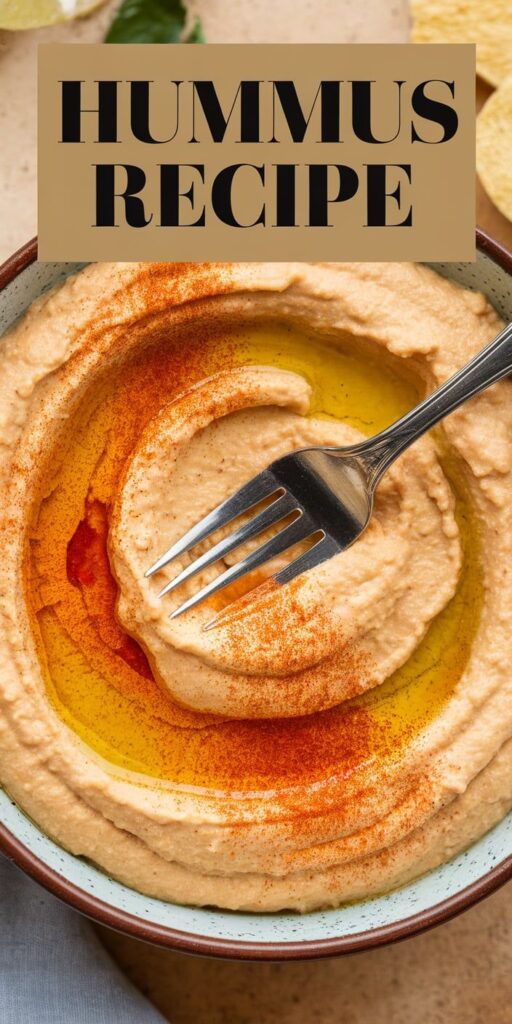Welcome to the most delicious journey into the world of hummus! I’m thrilled to share my ultimate classic hummus recipe that will transform your kitchen into a Mediterranean culinary paradise. This creamy, smooth Mediterranean dip is more than just a simple spread – it’s a celebration of flavors that will elevate your appetizer game.
My hummus recipe is a tried-and-true method that brings authentic taste straight to your table. Whether you’re a seasoned cook or a kitchen newbie, you’ll find this guide incredibly easy to follow. We’ll explore every aspect of creating the perfect hummus, from its rich cultural roots to the most mouthwatering preparation techniques.
Get ready to learn why homemade hummus beats any store-bought version. I’ll walk you through selecting the best ingredients, mastering the blending technique, and discovering creative ways to serve this incredible dip. From traditional preparation to exciting flavor variations, this guide has everything you need to become a hummus expert.
Grab your ingredients, and let’s embark on this delicious culinary adventure together!

What Makes Traditional Hummus So Special
Traditional hummus represents more than just a simple dip – it’s a culinary journey through centuries of Mediterranean culture. This creamy delicacy has captured the hearts of food lovers worldwide, blending rich history with incredible nutritional value.
The Ancient Origins of Hummus
Hummus traces its roots back to ancient Middle Eastern civilizations. Archaeological evidence suggests chickpea cultivation began over 7,000 years ago in the Levant region. The word “hummus” comes from Arabic, meaning “chickpea,” highlighting its deep cultural significance.
- Originated in the Middle East
- Documented in ancient cookbooks
- Spread across Mediterranean cultures
Health Benefits of This Mediterranean Staple
Homemade hummus packs an impressive nutritional punch. Packed with protein, fiber, and essential minerals, this Mediterranean treasure supports overall wellness.
| Nutrient | Amount per 1/4 cup |
|---|---|
| Protein | 4-5 grams |
| Fiber | 3-4 grams |
| Healthy Fats | 5-6 grams |
Why Homemade Beats Store-Bought Every Time
Store-bought hummus can’t compete with the freshness and flavor of homemade versions. By preparing traditional hummus in your kitchen, you control ingredients, avoid preservatives, and customize flavors to your liking.
- Fresh ingredients
- No artificial preservatives
- Customizable flavor profiles
- More cost-effective
Essential Ingredients for Perfect Hummus Recipe
Creating authentic hummus starts with selecting the right hummus ingredients. My journey to crafting the perfect hummus taught me that quality matters most when choosing each component. The foundation of any great hummus recipe begins with top-notch chickpeas, which provide the creamy base and nutritional punch.
- Chickpeas (Garbanzo beans): The star ingredient that creates the signature texture
- Tahini: A rich sesame paste that adds depth and complexity
- Extra virgin olive oil: Provides smoothness and rich flavor
- Fresh garlic: Brings a zesty kick to the recipe
- Fresh lemon juice: Adds brightness and balances the flavors
- Sea salt: Enhances overall taste
When selecting chickpeas, I recommend using dried beans for the most authentic flavor. Soak them overnight to ensure a smooth, creamy consistency. The tahini should be fresh and smooth, with a nutty aroma that complements the chickpeas perfectly.
Quality olive oil makes a significant difference in your hummus. Look for cold-pressed, extra virgin olive oil with a rich, fruity flavor. A good olive oil will elevate your hummus from ordinary to extraordinary, creating a luxurious texture that spreads like silk.
Kitchen Tools You’ll Need for Smooth Hummus
Creating the perfect hummus requires more than just great ingredients. The right hummus kitchen tools can make a significant difference in achieving that creamy, smooth texture we all love. Let me walk you through the essential equipment you’ll need to craft an outstanding hummus at home.
Selecting the right appliance is crucial for transforming chickpeas into a silky-smooth dip. When it comes to blending, you’ll primarily choose between two key tools:
Food Processor vs Blender: Choosing Your Hummus Companion
A food processor for hummus is typically the top recommendation among home cooks. Its wide bowl and sharp blade design make it ideal for creating ultra-smooth textures. The machine allows you to scrape down sides easily and process ingredients more evenly.
While a blender for hummus can work, it often requires more liquid and frequent stopping to push ingredients down. Professional chefs typically prefer food processors for their superior consistency and control.
Additional Equipment for Preparation
- Measuring cups for precise ingredient ratios
- Sharp chef’s knife for chopping garlic and herbs
- Rubber spatula for scraping down processor sides
- Lemon juicer for fresh citrus
- Fine mesh strainer for rinsing chickpeas
Pro tip: Invest in a high-quality food processor with at least 500 watts of power. This ensures smooth blending and prevents strain on the motor when processing dense ingredients like chickpeas.
My Secret Tips for Ultra-Creamy Texture
Achieving the perfect smooth hummus texture isn’t just about following a recipe – it’s an art form I’ve perfected over years of kitchen experiments. Let me share my top creamy hummus tips that will transform your homemade dip from ordinary to extraordinary.
The secret to ultra-creamy hummus starts with chickpea preparation. Here are my insider techniques:
- Remove chickpea skins completely for an impossibly smooth texture
- Use ice-cold water during blending to create a lighter consistency
- Blend longer than you think necessary – patience is key
Tahini plays a crucial role in creating that silky smooth hummus texture. I recommend using high-quality tahini and incorporating it gradually while blending. The right ratio can make all the difference between good and outstanding hummus.
Consistency is everything when crafting creamy hummus. Start with small amounts of liquid and add gradually. A food processor works best for breaking down chickpeas into the most velvety texture possible. Don’t be afraid to experiment and adjust – each batch is an opportunity to perfect your technique.
Pro tip: Let your hummus rest for 30 minutes after blending. This allows the flavors to meld and the texture to become even more luxurious. Trust me, these creamy hummus tips will elevate your homemade dip to restaurant-quality deliciousness.
Step-by-Step Hummus Recipe Instructions
Creating the perfect homemade hummus is an art that requires precision and care. My hummus recipe instructions will guide you through each essential step to craft a creamy, delicious dip that rivals any store-bought version. Let’s dive into the process of how to make hummus that will impress your family and friends.
Before we begin, gather all your ingredients and tools. The right preparation makes all the difference in achieving that silky smooth texture everyone loves.
Preparing the Chickpeas
Chickpea preparation is crucial for an exceptional hummus blending technique. You have two primary options:
- Canned chickpeas (quick method)
- Drain and rinse thoroughly
- Remove outer skins for smoother texture
- Dried chickpeas (traditional method)
- Soak overnight in cold water
- Boil until soft (about 1-2 hours)
Blending Technique for Silky Results
Mastering the hummus blending technique separates good from great hummus. I recommend using a food processor for the smoothest results.
- Start with chickpeas in the processor
- Add tahini and blend until creamy
- Gradually incorporate olive oil
- Add lemon juice and garlic
Adding Flavors and Seasonings
The final touch that elevates your hummus comes from perfectly balanced seasonings. Here’s a quick flavor guide:
| Seasoning | Quantity | Impact |
|---|---|---|
| Salt | 1/2 tsp | Enhances overall flavor |
| Cumin | 1/4 tsp | Adds warm, earthy notes |
| Paprika | Pinch | Provides subtle heat |
Pro tip: Always taste and adjust seasonings gradually. The perfect hummus is a balance of flavors that dance on your palate.
Creative Hummus Variations and Toppings
Transforming a classic hummus recipe into something extraordinary is easier than you might think. Flavored hummus opens up a world of culinary creativity, allowing you to personalize this beloved Mediterranean dip with unique ingredients and exciting combinations.
Let me share some of my favorite hummus variations that will elevate your appetizer game:
- Roasted Red Pepper Hummus: Blend in charred bell peppers for a smoky, sweet twist
- Spicy Harissa Hummus: Add a kick with traditional North African chili paste
- Garlic-Herb Hummus: Mix in fresh herbs and roasted garlic for intense flavor
- Sun-Dried Tomato Hummus: Incorporate tangy sun-dried tomatoes for a Mediterranean flair
When it comes to hummus toppings, the possibilities are endless. I love creating visual and flavor contrasts that make my hummus stand out. Some of my go-to toppings include:
- Toasted pine nuts for crunch
- Za’atar spice blend for earthy complexity
- High-quality extra virgin olive oil drizzle
- Chopped fresh herbs like parsley or cilantro
- Paprika or sumac for color and zest
Don’t be afraid to experiment with your own unique hummus variations. The beauty of this versatile dip is that it welcomes creativity and personal expression in the kitchen.
Serving and Storage Suggestions
When it comes to how to serve hummus, I’ve discovered endless delicious possibilities. Fresh homemade hummus works beautifully with warm pita bread, crisp vegetable crudités, and even sturdy crackers. My favorite presentation trick involves creating a shallow well in the center, drizzling extra virgin olive oil, and sprinkling some smoked paprika for visual appeal and additional flavor.
Storing homemade hummus requires some careful attention. I recommend keeping your freshly prepared dip in an airtight container within the refrigerator, where it typically maintains peak quality for 4-5 days. Always use a clean utensil when scooping to prevent bacterial contamination and maintain the hummus’s pristine texture.
For adventurous hummus dippers, consider exploring unique serving options. Roasted vegetable sticks, whole grain chips, or even cucumber rounds can transform your homemade hummus into an exciting appetizer. If you’re planning ahead, remember that freezing works well – just ensure you store it in a freezer-safe container and consume within one month for optimal taste and consistency.
Pro tip: Before serving refrigerated hummus, let it sit at room temperature for 15-20 minutes. This simple step helps restore its creamy texture and enhances the overall flavor profile, making your homemade creation taste just as delightful as when you first prepared it.



